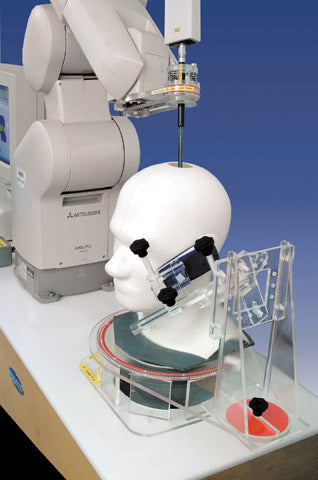The WaveWall Blog
How are Phones Tested for Radiation?
In the 1980s, the US Federal Communications Commission (FCC) came out with a model to test the Specific Absorption Rate (SAR) of mobile radiation that has remained unchanged since.
Hi, SAM!

The model is called a SAM (standard anthropomorphic model) and is made of fluid that simulates electrical properties of human tissue (made of salt, sugar, water, and viscosity additive). Chosen by the US Army Personnel in 1980, the model is an 11lb (5kg) adult-sized head based off a human figure that weighs 220 lbs (100kg) and is 6ft 2″ tall (1.88m). This model was chosen as the 90th percentile dimensions of the adult male head (so you can imagine that this is a giant head)! Because the model is so large, it completely underestimates the effects of electromagnetic radiation on the majority of the population—especially children. Informa Healthcare also published a study that shows evidence of this here.
With the current SAM model, companies such as cetecom are able to test for SAR ratings (specific absorption rate), which measures how much electromagnetic radiation is absorbed into the human tissue in watts per kilogram. In general, the lower the SAR rating, the safer the product. Though there is some debate on how helpful these ratings really are.
Currently, the FCC limits for SAR are 1.6 W/kg for partial-body exposure, 0.08 W/kg for whole-body exposure, and 4 W/kg for hands, feet, wrists, and ankles.
They keep a controlled temperature in the testing chamber of 70.7 degrees Fahrenheit (21.5 degrees Celsius) with a humidity of 36.1%, which is the equivalent of a nice, sunny day in San Francisco.
The Actual Process (20-30 minutes)
- The phone is attached to SAM (the head model) so that the antenna is positioned near the jaw.
- Ring ring! The phone is put through a simulated call with a radio communication tester, testing the signal at full power.
- A robotic probe scans SAM (the head model) for radio frequency energy that is absorbed at different points
- Averages are taken per 1 gram of tissue and the probe finds the region with the highest absorption rate in W/kg.
- This is your SAR rating! Make sure it is within the legal limits (1.6W/kg)!
Find an inside look of the lab here.
Do you think they should update the SAM model?
Do you feel safe with your phone being tested using this procedure?
What would you like to see being done for mobile radiation testing?
Share your thoughts in the comment section below!
You may also be interested in…
- Are SAR ratings still relevant to today’s mobile phones?
- Warning: Your phone may be hazardous to your health. Sound familiar?
- Protect Yourself From Mobile Phone Radiation
